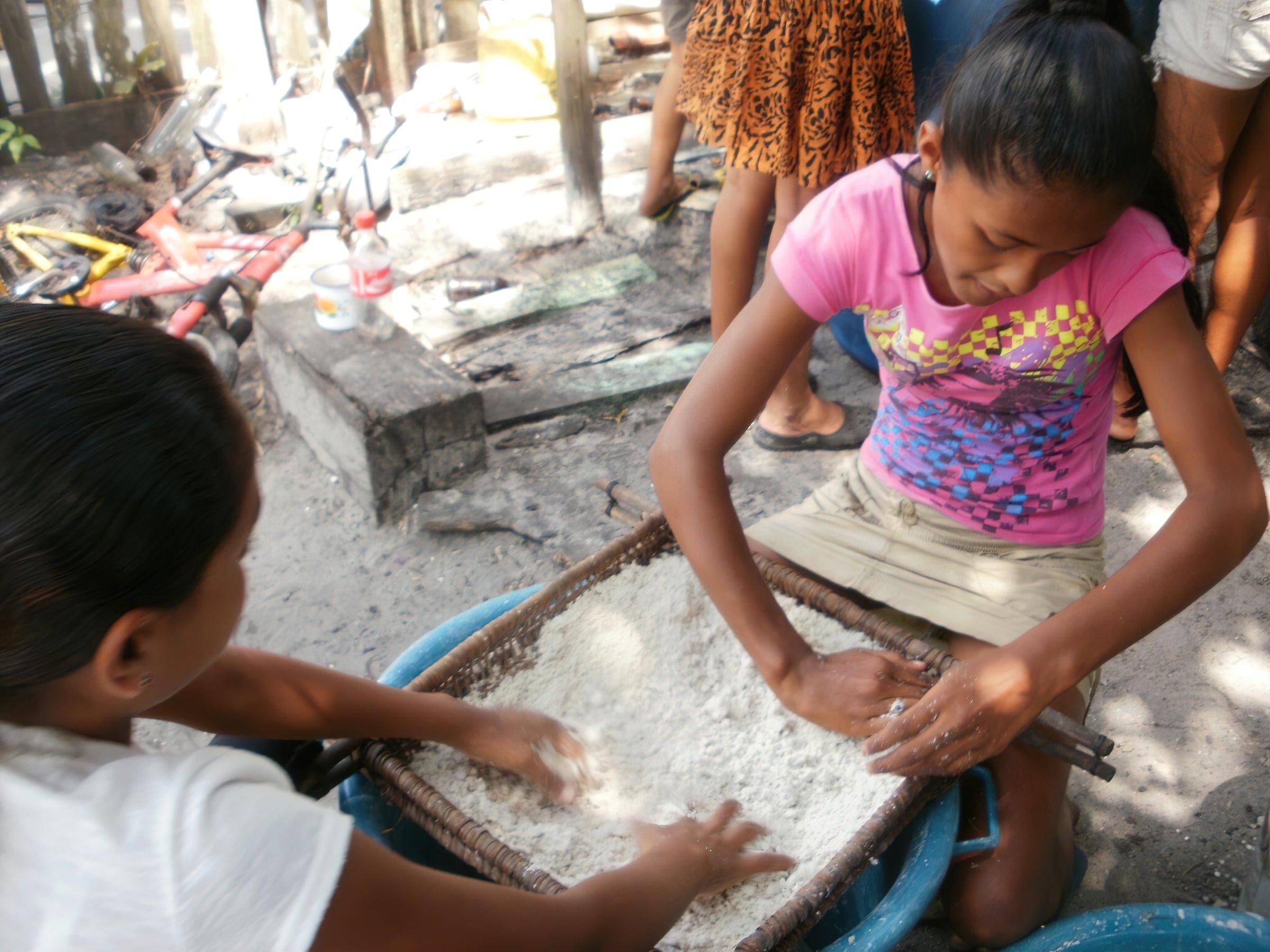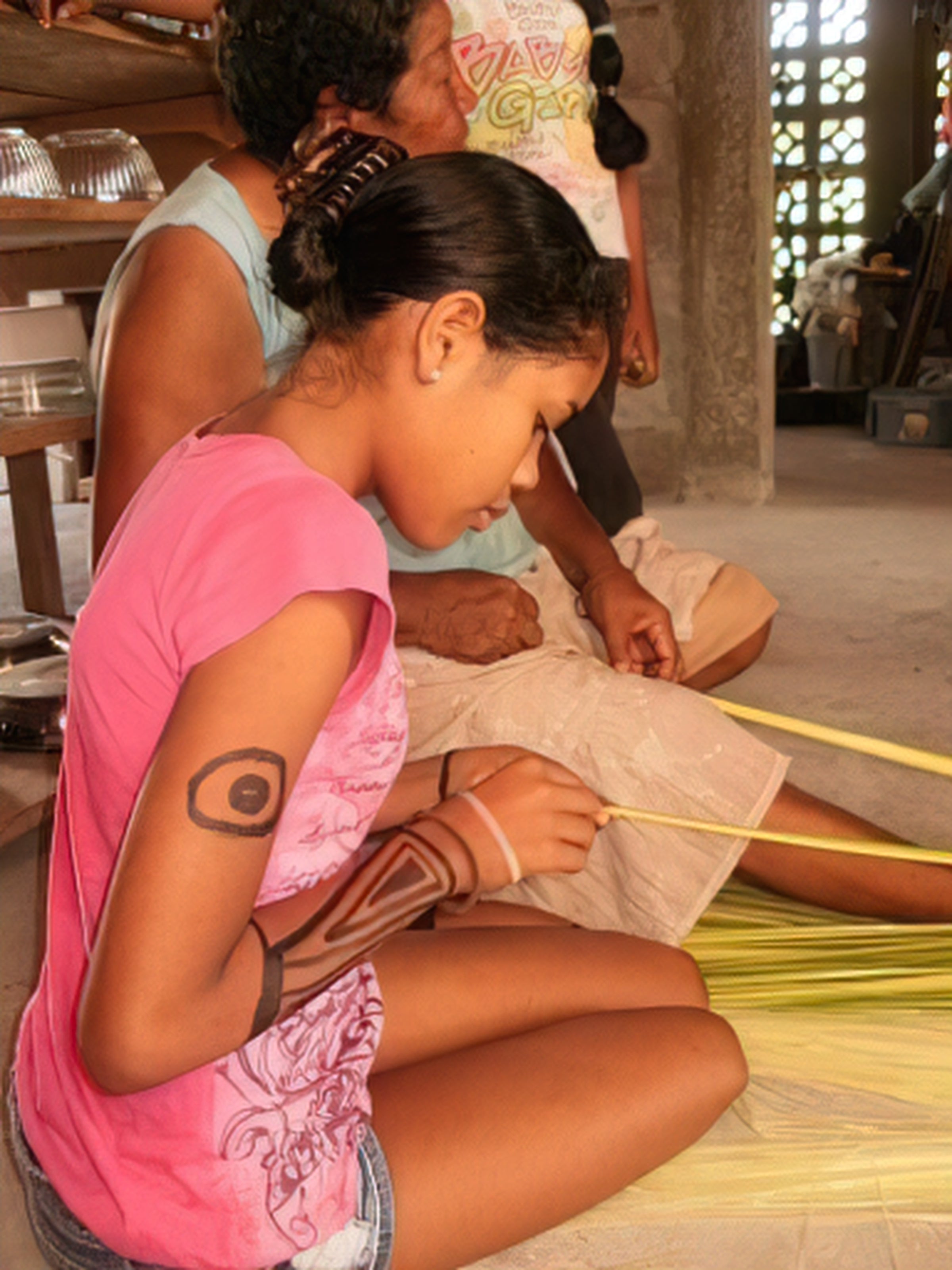My name is Sabantho Aderi, which in the Lokono-Arawak language means, “Beautiful Little Ground Dove.” I am a 22-year-old Indigenous woman living in an urban society outside of my ancestral community: a 240-square mile, 1,700- person ancestral Pakuri Lokono-Arawak territory in Region 4, Guyana, Northeast South America. I live in Barbados, another island nation altogether, in the Eastern Lesser Antilles in the Caribbean.
Maintaining my Indigenous identity, culture, and practices is not difficult because I am lucky enough to have pro-traditionalist Lokono-Arawaks for parents. My Barbados-born father is a descendent of our last hereditary traditional clan chief in Guyana, and he is a well versed historian on all aspects of our traditional culture and cosmovision. My mother was born and raised in her Tribal community and grew up living and breathing all things Lokono, and was also raised by two very traditionalist Lokono-Arawak parents. Living outside of my community has never made me feel like an outsider or displaced, especially since I had the privilege of returning to my Tribal lands at least once every year for summer vacation. Everytime I returned, I felt at home and as if I was never separated from my people.

Photo: Sabantho Aderi sifts strained cassava pulp granules before they are baked into a flat, unleavened bread.
At 12 years old, I became a woman in my Tribe, which required a demonstration of strength, both mentally and physically, to prove my desire and worthiness to achieve this honor. To earn the praise and respect of all elders and traditionalists in my Tribe, I had to go through our Lokono puberty right of passage, which consists of a nine-day ritual where a list of protocols, instructions, and taboos must be observed obediently through this sacred time in order to be become “a lady of high morals and standards” in the eyes of my people.
Through the completion of this ritual, I earned the rights to learn and be involved in all traditional, cultural, and spiritual ceremonies and rituals. I also earned the right to receive ancient spiritual blessings and abilities, as well as the rights to learn esoteric knowledge and wisdom on all important aspects of our culture, including the preservation and intergenerational transmission of tangible and intangible essential components of Lokono-Arawak culture and heritage.
During my ritual, my body was adorned every hour of the nine days with our traditional temporary face and body tattoos. I was taught the importance, hidden meanings, and spiritual significance of every shape and design of our tattoos so that I can pass the knowledge down to my children and grandchildren. I was not allowed to look at or be in close proximity to any males who did not share my DNA or who did not live in the same house as me. It is feared that if a girl were to do this while she is menstruating for the first time, she would become licentious and therefore unlady-like.
Along with this, I was also only allowed to drink one calabash of water per day and to eat one handful of cassava bread or one handful of farine (baked bitter cassava granules). This small amount of water and food was not just for myself; I also had to share it with my family. This practice was to teach me generosity and prepare me for experiencing potential food adversity in my life—and that even in such times of hunger and hardship, I must always share whatever little food I have equally with my family, and above all accept adversity with stoicism.
During my nine days, I also had to wake up and bathe soon after the sun had risen and bathe again just before the sun set. This was to remind me of the importance of always smelling, looking, and feeling clean like a beautiful flower, as this is one of our beauty and hygiene standards. I was also taught the importance and secret of yuri (tobacco), one of our most important plant medicines. I was taught how to plant it, harvest it, and how to use it properly, which is only for praying and healing others and never for personal pleasure or recreation. Tobacco prayer gatherings have a special protocol that includes the order of who smokes first and the direction in which the tobacco must be passed. I was taught by my grandmother how to boil and dry Tibisiri (a straw-like material) and how to weave it. This is one of our main materials that we make our traditional women’s regalia with, as well as mats, decorative storage bowls, and baskets. Lastly, I was taught about my family’s history in the Tribe and our Clan origin.
This puberty ritual for our girls was traditionally socially and culturally mandatory in our Tribe, but the dual effects of physical and spiritual colonization has now made it voluntary. Only if a girl requests it will her family give her the ritual, but if a girl has non-traditionalist parents she will not see or understand the importance or value of it. I am proud that like our mother and all our female ancestors before her, my little sister and I both requested and underwent this great honor test of womanhood.

Photo: Sabantho Aderi practices stripping palm leaves to make straw, a craft skill all traditionalist women in the Lokono-Arawak Tribe must know.
Each girl’s ritual may differ slightly, depending on what her parents or grandparents deem the most important lessons the girl needs to learn for her own higher good and that of the Tribe. For example, based on her childhood thoughts and actions hitherto, laziness or selfishness may have been dominant negative traits that need to be replaced. The most important parts according to our elders are always maintained in every girl’s ritual: meditating, praying, fasting, sharing, bathing, and no exposure to males outside the family or household.
What I find so beautiful in our community today is the fact that family members of girls who have started their first menstruation are never shy to ask other traditionalists for guidance on the proper protocols for the ritual. This ritual is still relatively common in our community, and sometimes you’ll hear jokes being made by people about their sister or cousin’s personality flaws or bad habits being due to the handling of her puberty ritual. My people will make jokes about nearly anything and everything, that’s why we have such thick skin when we face problems outside of the community—resilience built by humor.
Long ago, once a girl had finished her nine-day ritual, she would be allowed to start courting and later be married off to the first boy who had all the right qualities the parents knew a husband and father needed to have, because she was now seen as a woman in the eyes of the community. We have abandoned this practice with the help of science and more awareness of women’s bodily development. Many young women that were allowed to marry soon after their first menstruation and puberty ritual at the tender ages of 12 or 13 unfortunately died during childbirth due to birthing complications.
In this day and age our women are more aware of the options and opportunities available to them, so now we see more young women furthering their education and joining the workforce or becoming small business entrepreneurs and working for themselves, excelling in their studies and in their careers and serving the community in many other powerful ways. There is so much to obtain before taking on the very big, but beautiful, role of becoming a mother and bringing new life into this world.
We also understand that motherhood is not in the cards for everyone in this lifetime, but that does not change the fact that we stem from so many strong and beautiful women and that we ourselves are strong, beautiful women. This ritual is still—and I hope it will always be—an important part of our culture that is respected, cherished, and maintained. I am proud to come from a People that believe in the power of our cultural and spiritual practices.
— Sabantho Aderi (Lokono-Arawak), 22, is a member of the Pakuri Tribal Territory Indigenous community in Guyana. She is an Indigenous rights activist and artist and created the first Lokono-Arawak mural consisting of her Peoples’ mythological creatures and it is located in her Tribal lands. At 18, she became the youngest woman to participate in the United Nations Permanent Forum on Indigenous Issues Project Access Global Capacity Training Program sponsored via the Tribal Link Foundation.
All photos courtesy of Sabantho Aderi.
